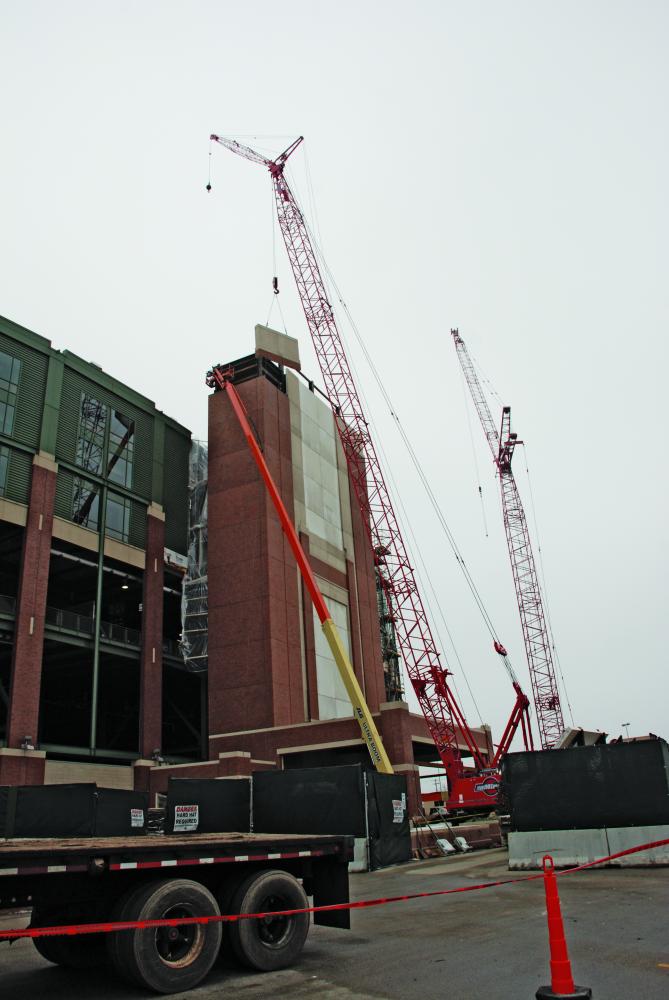


A team of six boom lifts, 11 scissor lifts, three straight-mast forklifts, four telehandlers and eight cranes are playing key roles in a $143-million construction project that is expanding and upgrading one of the most revered stadiums in all of sports: historic Lambeau Field, home of the National Football League’s Green Bay Packers.
The expansion and upgrading started in September 2011. Work will continue through 2012 and be completed before the 2013 NFL season starts. During the 2012 season, construction will not interfere with stadium use on game days.
The project will add about 6,700 seats above the south end zone, bringing the stadium’s total to 79,000. Although that will make Lambeau Field the NFL’s fourth-largest venue and add to the noise and excitement on game day, it will not shorten the line appreciably for the 96,000 fans waiting for a chance to buy season tickets.
A total of 1,600 construction workers from several trades will work on the project over its two-year duration, with about 300 working during peak activity. They are being supported by a fleet of aerial work platforms, telehandlers, hydraulic cranes, and lattice-boom crawler cranes.
Nearly all of the lifting equipment comes from the fleet of the project’s construction manager, Miron Construction, Neenah, Wis. Aerial work platforms also were rented from United Rentals.
The aerial lifts include JLG Model 1350 SJPs with maximum platform heights of 135 feet and platform capacities of 500 pounds, as well as JLG Model 860 SJs with maximum platform heights of 86 feet and platform capacities of 500 pounds. The aerial lifts are used to raise welders, carpenters, and laborers to high work locations as well as hard-to-reach work areas under low roofs and between the steel. Telehandlers on the job include JLG Model 8042s offering 8,000-pound maximum capacity, as well as 6,000-pound capacity at 41'11" maximum fork height, and 1,800-pound capacity at 26'7" of forward reach.
Lattice-boom crawler cranes working on the project include a 100-ton capacity Manitowoc Model 11000 with straight boom and fixed jib, a 220-ton capacity Manitowoc Model 14000 equipped with luffing jib, and twin 285-ton-capacity Liebherr Model LR1250s with luffing jibs.
Also working the project is a 50-ton Grove RT750 rough-terrain crane with 110 feet of telescopic boom.
Expansion includes more than seats
The equipment is helping construction workers put in new foundations, erect about 5,000 tons of supporting steel, pour 8,000 cubic yards of concrete, and place 150 brick façade panels. The largest trusses measure 81 feet high by 21 feet long and weigh 40,500 pounds. They are being placed at heights to 150 feet. Façade panels, mechanical equipment, and other materials will be lifted as high as 230 feet during the project.
In addition to the four levels of seats and the structure to support them, the expansion will add an enclosed concourse that will hold concessions and rest rooms for the new section; several elevators and escalators; a rooftop overlooking the north end zone; and two state-of-the-art jumbo scoreboard/videoboards each measuring 48 feet high by 108 feet wide. The new higher-resolution videoboards will replace existing scoreboards measuring just 25 feet tall by 46 feet wide.
Boston architectural firm Elkus Manfredi designed the addition. Hammes Company Sports Development Inc., Madison, Wis., is managing the Lambeau Field expansion.
Near the end of February, 46 organizations working on the Lambeau expansion, including contractors, subcontractors, and trade associations signed a partnership agreement spearheaded by the U.S. Department of Labor’s Occupational Safety and Health Administration, Miron Construction, and the Green Bay Packers, that will focus on reducing workers’ exposure to hazards and serious injury during the two-year project.
Frank Winningham, OSHA’s director for the area that includes Green Bay, said construction accidents—particularly workers’ falls—are the leading cause of fatalities in industry. The voluntary partnership focuses on identifying and controlling safety hazards and improving safety and health programs.